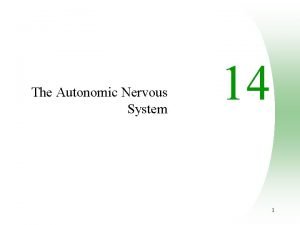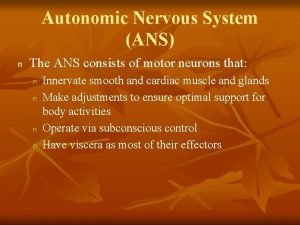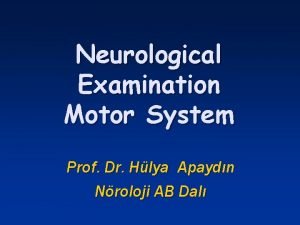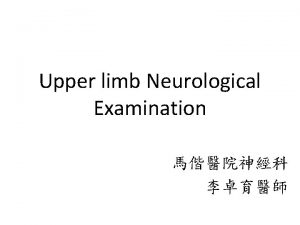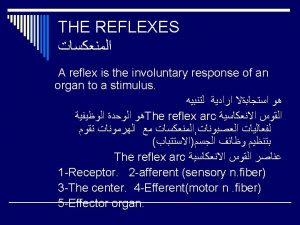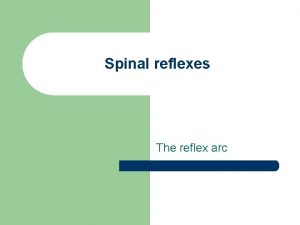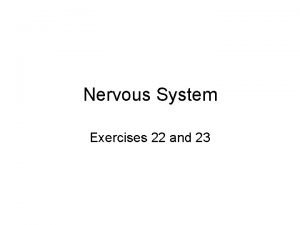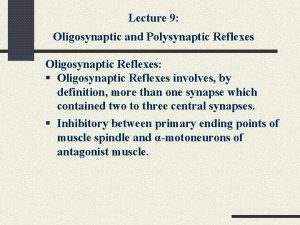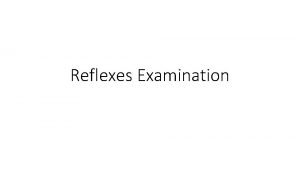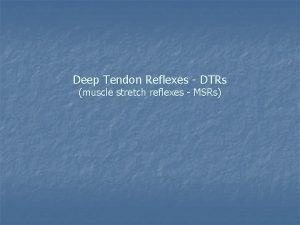REFLEXES What is a reflex n A reflex












- Slides: 12

REFLEXES

What is a reflex? n A reflex is an involuntary response to stimulus n n n A reflex can be a response to a stimulus or to internal feedback. Reflexes are necessary to survival. Involuntary reflexes can occur as fast as 320 miles per hour.

What is the function of a reflex? n The function of a reflex is to maintain homeostasis. n n Removes body from painful stimuli that could cause tissue damage. Prevents body from suddenly falling and moving. Maintains blood pressure, breathing rate, water intake, blood carbon dioxide levels (yawning), etc. Protects us from irritants: coughing, sneezing, vomiting, etc.

Reflexes n The actual anatomical and physiological basis behind a reflex is a reflex arc. n. A reflex arc is the simplest of all nerve pathways. n A nerve pathway is the route messages or information travels through the nervous system. n Involves at least 2 neurons – a sensory and motor neuron.

Components of a Reflex Arc n There are 5 basic components to a reflex arc: n n n Sensory receptor – a nerve or specialized tissue located at the end of a sensory neuron that is the first structure to respond to a stimulus. Sensory neuron – may act as the sensory receptor. Spinal cord or brain tissue Motor neuron Effector organ/tissue – the tissue that responds to the message from the motor neuron. n n Muscle Gland

Anatomy of a Stretch Reflex n n Simplest reflex arc. Involves two neurons. n n 1. Doctor taps your patellar tendon with a Taylor Reflex Hammer. 2. Sensory neuron conducts message of stimulation towards spinal cord through a nerve. 3. In the spinal cord, the sensory axon synapses with a motor neuron. 4. The motor axon carries the message out of the spinal cord to the synapse with the muscles of the thigh which results in contraction of the quadriceps muscle – response: knee extension.

Anatomy of a Stretch Reflex

Anatomy of a Withdrawal Reflex n n Involves three neurons. Function: remove a limb or body part form a painful stimulus. n n n 1. Step on a stone with your left foot. 2. A sensory neuron acts as a sensory receptor and is stimulated by the stone. 3. Sensory neuron conducts message to spinal cord.

Anatomy of a Withdrawal Reflex n n n 4. In the spinal cord, the sensory axon synapses with an interneuron. 5. The interneuron synapses with a motor neuron in the spinal cord. 6. The motor axon carries the message out of the spinal cord to the synapse with the muscles of the thigh which results in contraction of the hamstring muscles – response: knee flexion.

Anatomy of a Withdrawal Reflex

Importance of Testing Reflexes n Many of our somatic reflexes can be assessed. n Testing somatic reflexes is an important diagnostic tool. n n Assessment of somatic reflexes tells us something about the condition of the nervous system (usually the CNS). If a reflex is distorted, exaggerated, weak or absent this may indicate a problem in the nervous system. n This is usually one of the first signs of nervous system pathology.

Importance of Testing Reflexes n Pathology associated with abnormal reflexes n Absent reflexes n Demyelination n Muscular dystrophies n Spinal cord injuries n Closed head injuries n Exaggerated reflexes n Spinal stenosis – compression of spinal cord n Demyelination n Multiple sclerosis, ALS

